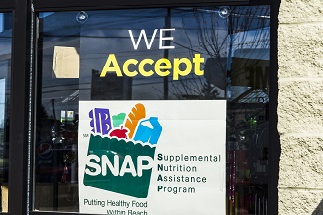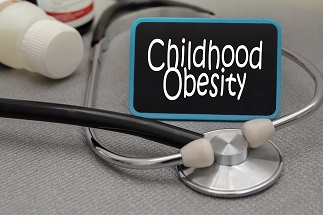Poor nutrition and obesity have serious consequences for health and well-being in the short-term and long-term. While all segments of the U.S. population can be affected by poor nutrition and obesity, low-income and food insecure people are especially vulnerable due to the additional risk factors associated with inadequate resources and under-resourced communities.
Quick Facts:
- 42.4% of U.S. adults and 19.3% of U.S. children are obese. Disparities exist based on race-ethnicity, gender, age, geographic region, and socioeconomic status.
- Food insecurity and obesity can co-exist in the same individual, family, or community.
- The strongest and most consistent evidence is for a higher risk of obesity among food insecure women.
- The federal nutrition programs play a critical role in improving nutrition and combating obesity.
Explore These Topics
- Obesity in the U.S.While some recent estimates suggest that the overall rates of obesity have plateaued or even declined among certain groups, obesity is widespread and continues to be a leading public health problem in the U.S. In addition, severe obesity is a serious and increasing problem among children, adolescents, and adults. Substantial disparities also exist based on race-ethnicity, gender, age, geographic region, and socioeconomic status.
Find out more about U.S. obesity rates and trends and state and local obesity data sources.
- Consequences of Poor NutritionAmericans from all income groups fall short of meeting federal dietary guidance — consuming diets too low in fruits, vegetables, whole grains, and low fat dairy, and consuming diets too high in added sugars, sodium, and solid fats.
In general, poor dietary intake (e.g., excess saturated or trans fat intake, a diet low in fruits and vegetables) has been linked to a number of diseases and chronic conditions, including the following:
- Cardiovascular disease;
- Type 2 diabetes;
- Obesity;
- Some types of cancer; and
- Osteoporosis.
In addition, inadequate dietary intake during pregnancy and early childhood — which may be a consequence of food insecurity — can increase the risk for:
- Birth defects;
- Anemia;
- Low birth weight;
- Preterm birth; and
- Developmental risk.
Find out more about the connections between poor nutrition and health, including sources for the above information.
- Consequences of Childhood ObesityObesity in childhood (including adolescence) is associated with serious physiological, psychological, and social consequences. Many of these consequences manifest during childhood, others later in life. Of great concern is that children who are obese are more likely to be obese as adults.
Examples of physiological consequences include:
- Diabetes;
- High cholesterol;
- High blood pressure;
- Gallbladder disease;
- Liver disease;
- Asthma;
- Sleep apnea and sleep disordered breathing;
- Orthopedic complications; and
- Poor health-related quality of life.
Examples of psychological and social consequences include:
- Depression;
- Anxiety;
- Low self-esteem;
- Stigmatization;
- Bullying;
- Poor academic performance; and
- School absenteeism.
Sources: Bethell et al., 2010; Carey et al., 2015; and Centers for Disease Control and Prevention, 2016.
- Consequences of Adult ObesityObesity in adulthood is associated with many serious physiological, psychological, and social consequences.
Examples of physiological consequences include:
- Diabetes;
- High blood pressure;
- Dyslipidemia (e.g., high blood cholesterol and triglycerides);
- Heart disease;
- Stroke;
- Gallbladder disease;
- Sleep apnea and breathing problems;
- Arthritis;
- Pain and mobility limitations;
- Some types of cancer;
- Reproduction and pregnancy-related complications (e.g., birth defects, gestational diabetes, preeclampsia);
- Poor health-related quality of life; and
- Increased all-cause mortality.
Examples of psychological and social consequences include:
- Depression;
- Anxiety;
- Discrimination and stigmatization; and
- Disruption of work, family, and social life.
Sources: Academy of Nutrition and Dietetics, 2016; Centers for Disease Control and Prevention, 2015; Puhl & Heuer, 2010; and Rodbard et al., 2009.
- Factors Contributing to ObesityObesity is a complex condition with biological, genetic, behavioral, social, cultural, and environmental influences. For example:
- Individual behaviors and environmental factors can contribute to excess caloric intake and inadequate amounts of physical activity. The current high rates of obesity have been attributed to, in part, increased snacking and eating away from home, larger portion sizes, greater exposure to food advertising, limited access to physical activity opportunities, and labor-saving technological advances.
- Certain medical conditions (e.g., polycystic ovary syndrome) and prescription drugs (e.g., steroids, anti-depressants) can cause weight gain.
- Recent evidence suggests that inadequate sleep, prenatal and post-natal influences (e.g., maternal pre-pregnancy weight status, maternal smoking during pregnancy), chemical exposure, and stress may affect energy balance or obesity risk.
- Race-ethnicity, gender, age, income, and other socio-demographic factors also can play a role in this complex health issue.
Many of these and other contributing factors affect everyone at some point during their lives, at least to some extent, but those who are food-insecure or low-income face additional challenges and risks.
Source: The Obesity Society Infographic Task Force, 2015.
- Relationship Between Poverty and ObesityWhile all segments of the U.S. population are affected by obesity, one of the common myths that exists is that all or virtually all low-income people are far more likely to be obese. This generalization overlooks the research showing that the relationship between income and obesity is complex, and varies by gender and race-ethnicity. For example:
- Obesity rates tend to increase with decreased income among women overall. While this overall pattern persists among White, Hispanic, and Asian women, it is only significant among White women. Among Black women, there are no significant differences in obesity rates by income group. These same trends are observed among females 2 to 19 years of age.
- Among men, the association between obesity and income is much more complicated: obesity rates are fairly similar across income groups among Asian men, significantly higher at higher levels of income for Black men, and tend to be higher in the middle-income group among White and Hispanic men. For boys, obesity rates are higher at lower levels of income for Asian and Hispanic boys, but there are no significant differences in obesity rates by income group for White and Black boys.
Sources: Ogden et al., 2017; and Ogden et al., 2018.
- Relationship Between Hunger and ObesityThe extent of research on food insecurity and obesity has grown considerably since 1995, when a leading pediatrician published a medical case report that proposed a relationship between hunger and obesity.
At first, the relationship between food insecurity and obesity was considered counterintuitive and labeled a paradox. This was due, in part, to our limited understanding of the causes and consequences of food insecurity. But now, with a more extensive research base and comprehensive conceptual framework, researchers conclude that the “coexistence of food insecurity and obesity is expected given that both are consequences of economic and social disadvantage” (Frongillo & Bernal, 2014).
While food insecurity and obesity can co-exist in the same individual, family, or community, the research on whether there is a statistically significant relationship provides mixed results.
- A number of research studies in the U.S. have found positive associations between food insecurity and overweight or obesity.
- Other studies have found no relationship, or even a lower risk of overweight or obesity with food insecurity.
- Associations, or lack thereof, often differ by gender, age, and/or race-ethnicity.
Overall, based on several reviews of the literature, the strongest and most consistent evidence is for a higher risk of obesity among food-insecure women.
Find out more about the connections between hunger and obesity, including sources for the above information.
- Why Low-Income and Food-Insecure People are Vulnerable to Poor Nutrition and ObesityFood-insecure and low-income people can be especially vulnerable to poor nutrition and obesity, due to additional risk factors associated with inadequate household resources as well as under-resourced communities. This might include:
- Lack of access to healthy and affordable foods;
- Cycles of food deprivation and overeating;
- High levels of stress, anxiety, and depression;
- Fewer opportunities for physical activity;
- Greater exposure to marketing of obesity-promoting products; and
- Limited access to health care.
In addition to these unique challenges, those who are food insecure or low income are subject to the same challenges (e.g., more sedentary lifestyles, increased portion sizes) as other Americans in trying to adopt and maintain healthful behaviors.
Find out more about the unique challenges faced by food-insecure and low-income people, including sources for the above information.
- Role of the Federal Nutrition Programs in Improving Nutrition and Combating ObesityResearch clearly shows that the federal nutrition programs have not caused the current high rates of obesity in the U.S. In fact, by both improving dietary intake and reducing food insecurity, participation in the federal nutrition programs plays an important role in addressing obesity. Consider the following:
- Low-income students who eat both school breakfast and lunch have significantly better overall diet quality than low-income students who do not eat school meals (Hanson & Olson, 2013).
- Based on national data, economists estimate that free or reduced-price school lunches reduce obesity rates by at least 17 percent (Gundersen et al., 2012).
- Children in afterschool programs consume more calories, salty foods, and sugary foods on days they bring their own snack than on days they only eat the afterschool snack provided by the National School Lunch Program or the Child and Adult Care Food Program (CACFP) (Kenney et al., 2014).
- Among low-income preschoolers, participating in CACFP is associated with greater fruit, vegetable, and milk consumption and lower likelihood of obesity (Gordon et al., 2010; Korenman et al., 2013).
- WIC may protect against obesity among young children in families facing multiple stressors (i.e., household food insecurity and caregiver depressive symptoms) (Black et al., 2012).
- In a national study of low-income adults, SNAP participants with marginal, low, or very low food security had lower body mass index (BMI) (Nguyen et al., 2015). In addition, the probability of obesity was lower among SNAP participants experiencing marginal food security. The authors concluded that SNAP participation appears to buffer against obesity among those who are food insecure.
Find out more about the role of SNAP and the Child Nutrition Programs in improving dietary intake and addressing obesity.
Recent Publications

The Impact of Poverty, Food Insecurity, and Poor Nutrition on Health and Well-Being
Read more
The Role of the Supplemental Nutrition Assistance Program in Improving Health and Well-Being
Read more
The Role of the Federal Child Nutrition Programs in Improving Health and Well-Being
Read more
The Importance of the Federal Nutrition Programs for Infants and Toddlers
Read more
Understanding the Connections: Food Insecurity and Obesity
Read more
WIC is a Critical Economic, Nutrition, and Health Support for Children and Families
Read more
Impact of the Revised WIC Food Packages on Nutrition Outcomes and the Retail Food Environment
Read more
Research Shows that the School Nutrition Standards Improve the School Nutrition Environment and Student Outcomes
Read more
